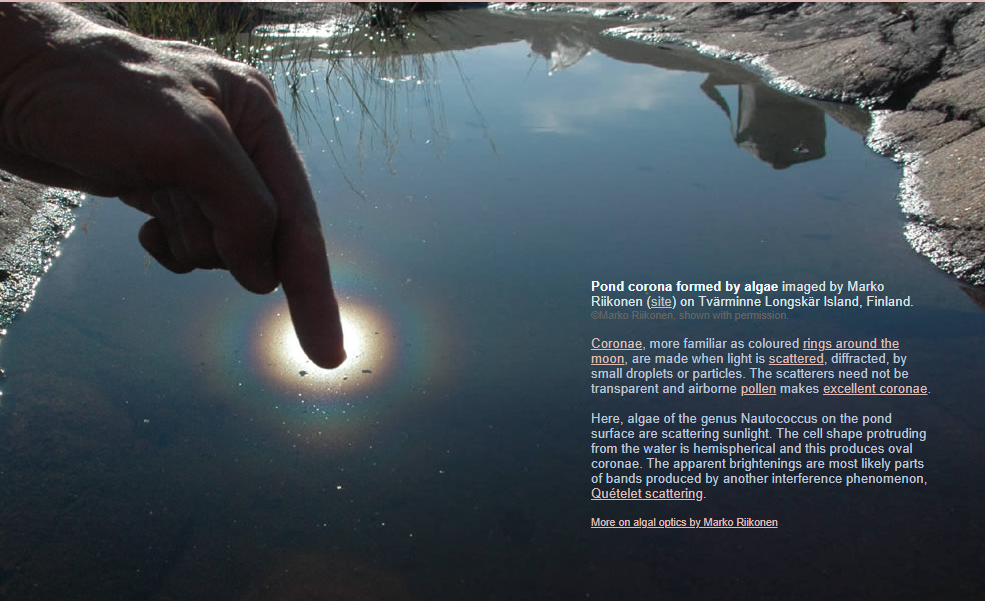Pond Life ~ Algea Corona
Pond Life ~ Algae Corona: A Fascinating Natural Phenomenon
Have you ever noticed colored rings around the moon? These beautiful rings, known as coronae, are formed when light is scattered and diffracted by small droplets or particles in the atmosphere. While coronae are commonly associated with airborne pollen, they can also be created by other scatterers, including algae. In this article, we will explore the intriguing world of algae corona and how these microscopic organisms can produce stunning optical effects on the surface of ponds.
Algae, specifically the genus Nautococcus, play a crucial role in creating corona formations on pond surfaces. These single-celled organisms have a distinct hemispherical shape that protrudes from the water. When sunlight interacts with these algae, it undergoes scattering, resulting in the formation of oval coronae. The interplay between the shape of the algae cells and the incident light leads to the mesmerizing patterns we observe.
While the algae corona itself is a remarkable sight, there are additional phenomena at play that enhance its visual appeal. The apparent brightenings within the corona are likely caused by bands produced through Quételet scattering, another interference phenomenon. These bands add further complexity and intricacy to the overall pattern, captivating observers with their ethereal beauty.
To fully appreciate the significance of algae corona, it's important to understand the broader field of algal optics. Researchers like Marko Riikonen have dedicated their efforts to studying the optical properties of algae and uncovering the mechanisms behind these captivating natural phenomena. Through their work, we gain a deeper understanding of the intricate interplay between light and microscopic life forms in our environment.
The study of algal optics not only provides aesthetic pleasure but also has practical applications. Algae are essential components of aquatic ecosystems, serving as primary producers and playing a vital role in nutrient cycling. By examining their optical properties, scientists can gain insights into the health and dynamics of aquatic environments. Algae corona serves as a visual indicator of the presence and activity of these organisms, allowing researchers to monitor changes in their populations and assess the overall ecological balance.
In addition to their ecological significance, algae corona can also serve as a source of inspiration for artists and photographers. The delicate and intricate patterns created by these microscopic organisms offer a unique subject for creative expression. Capturing the beauty of algae corona through various artistic mediums allows us to appreciate the wonders of nature and share its enchantment with others.
As we delve deeper into the world of atmospheric optics, we realize that there is still much to learn and explore. The intricate interactions between light and matter continue to amaze us, revealing the hidden complexities of the natural world. Algae corona stands as a testament to the beauty and diversity of optical phenomena, reminding us of the fascinating wonders that surround us, even in the most unexpected places.
In conclusion, algae corona is a captivating natural phenomenon that occurs when light interacts with microscopic algae on the surface of ponds. These single-celled organisms scatter sunlight, resulting in the formation of oval coronae. The interplay between the shape of the algae cells and incident light creates mesmerizing patterns enhanced by bands produced through Quételet scattering. Studying algal optics not only provides aesthetic pleasure but also contributes to our understanding of aquatic ecosystems. Algae corona serves as a visual indicator of the presence and activity of these organisms, while also inspiring artists and photographers. The world of atmospheric optics continues to astound us, revealing the intricate beauty and complexity that exists within our natural environment.

Pond corona formed by algae imaged by Marko Riikonen (site) on Tvärminne Longskär Island, Finland. ©Marko Riikonen, shown with permission.
Coronae, more familiar as coloured rings around the moon, are made when light is scattered, diffracted, by small droplets or particles. The scatterers need not be transparent and airborne pollen makes excellent coronae.
Here, algae of the genus Nautococcus on the pond surface are scattering sunlight. The cell shape protruding from the water is hemispherical and this produces oval coronae. The apparent brightenings are most likely parts of bands produced by another interference phenomenon, Quételet scattering.
More on algal optics by Marko Riikonen
Note: this article has been automatically converted from the old site and may not appear as intended. You can find the original article here.
Reference Atmospheric Optics
If you use any of the definitions, information, or data presented on Atmospheric Optics, please copy the link or reference below to properly credit us as the reference source. Thank you!
-
<a href="https://atoptics.co.uk/blog/pond-life-algea-corona/">Pond Life ~ Algea Corona</a>
-
"Pond Life ~ Algea Corona". Atmospheric Optics. Accessed on April 24, 2024. https://atoptics.co.uk/blog/pond-life-algea-corona/.
-
"Pond Life ~ Algea Corona". Atmospheric Optics, https://atoptics.co.uk/blog/pond-life-algea-corona/. Accessed 24 April, 2024
-
Pond Life ~ Algea Corona. Atmospheric Optics. Retrieved from https://atoptics.co.uk/blog/pond-life-algea-corona/.